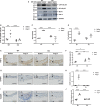Inflammatory Role of Milk Fat Globule-Epidermal Growth Factor VIII in Age-Associated Arterial Remodeling
- PMID: 36000422
- PMCID: PMC9496444
- DOI: 10.1161/JAHA.121.022574
Inflammatory Role of Milk Fat Globule-Epidermal Growth Factor VIII in Age-Associated Arterial Remodeling
Abstract
Background Age-associated aortic remodeling includes a marked increase in intimal medial thickness (IMT), associated with signs of inflammation. Although aortic wall milk fat globule-epidermal growth factor VIII (MFG-E8) increases with age, and is associated with aortic inflammation, it is not known whether MFG-E8 is required for the age-associated increase in aortic IMT. Here, we tested whether MFG-E8 is required for the age-associated increase in aortic IMT. Methods and Results To determine the role of MFG-E8 in the age-associated increase of IMT, we compared aortic remodeling in adult (20-week) and aged (96-week) MFG-E8 (-/-) knockout and age matched wild-type (WT) littermate mice. The average aortic IMT increased with age in the WT from 50±10 to 70±20 μm (P<0.0001) but did not significantly increase with age in MFG-E8 knockout mice. Because angiotensin II signaling is implicated as a driver of age-associated increase in IMT, we infused 30-week-old MFG-E8 knockout and age-matched littermate WT mice with angiotensin II or saline via osmotic mini-pumps to determine whether MFG-E8 is required for angiotensin II-induced aortic remodeling. (1) In WT mice, angiotensin II infusion substantially increased IMT, elastic lamina degradation, collagen deposition, and the proliferation of vascular smooth muscle cells; in contrast, these effects were significantly reduced in MFG-E8 KO mice; (2) On a molecular level, angiotensin II treatment significantly increased the activation and expression of matrix metalloproteinase type 2, transforming growth factor beta 1, and its downstream signaling molecule phosphorylated mother against decapentaplegic homolog 2, and collagen type I production in WT mice; however, in the MFG-E8 knockout mice, these molecular effects were significantly reduced; and (3) in WT mice, angiotensin II increased levels of aortic inflammatory markers phosphorylated nuclear factor-kappa beta p65, monocyte chemoattractant protein 1, tumor necrosis factor alpha, intercellular adhesion molecule 1, and vascular cell adhesion molecule 1 molecular expression, while in contrast, these inflammatory markers did not change in knockout mice. Conclusions Thus, MFG-E8 is required for both age-associated proinflammatory aortic remodeling and also for the angiotensin II-dependent induction in younger mice of an aortic inflammatory phenotype observed in advanced age. Targeting MFG-E8 would be a novel molecular approach to curb adverse arterial remodeling.
Keywords: age‐associated aortic remodeling; angiotensin II signaling; inflammation; intimal medial thickening; milk fat globule–epidermal growth factor 8.
Figures






Similar articles
-
Milk fat globule protein epidermal growth factor-8: a pivotal relay element within the angiotensin II and monocyte chemoattractant protein-1 signaling cascade mediating vascular smooth muscle cells invasion.Circ Res. 2009 Jun 19;104(12):1337-46. doi: 10.1161/CIRCRESAHA.108.187088. Epub 2009 May 14. Circ Res. 2009. PMID: 19443842 Free PMC article.
-
Milk fat globule epidermal growth factor VIII signaling in arterial wall remodeling.Curr Vasc Pharmacol. 2013 Sep;11(5):768-76. doi: 10.2174/1570161111311050014. Curr Vasc Pharmacol. 2013. PMID: 22272902 Free PMC article. Review.
-
MFG-E8 mediates arterial aging by promoting the proinflammatory phenotype of vascular smooth muscle cells.J Biomed Sci. 2019 Aug 30;26(1):61. doi: 10.1186/s12929-019-0559-0. J Biomed Sci. 2019. PMID: 31470852 Free PMC article.
-
MFG-E8 Reduces Aortic Intimal Proliferation in a Murine Model of Transplant Vasculopathy.Int J Mol Sci. 2022 Apr 7;23(8):4094. doi: 10.3390/ijms23084094. Int J Mol Sci. 2022. PMID: 35456911 Free PMC article.
-
Roles and mechanisms of MFG-E8 in vascular aging-related diseases.Ageing Res Rev. 2020 Dec;64:101176. doi: 10.1016/j.arr.2020.101176. Epub 2020 Sep 21. Ageing Res Rev. 2020. PMID: 32971257 Review.
Cited by
-
The role of splicing events in the inflammatory response of atherosclerosis: molecular mechanisms and modulation.Front Immunol. 2024 Dec 17;15:1507420. doi: 10.3389/fimmu.2024.1507420. eCollection 2024. Front Immunol. 2024. PMID: 39742258 Free PMC article. Review.
-
Enhanced vasorin signaling mitigates adverse cardiovascular remodeling.Aging Med (Milton). 2024 Jun 19;7(3):414-423. doi: 10.1002/agm2.12332. eCollection 2024 Jun. Aging Med (Milton). 2024. PMID: 38975316 Free PMC article. Review.
-
Effects of GDF6 on active protein synthesis by cells of degenerated intervertebral disc.Eur Spine J. 2025 Jun;34(6):2066-2078. doi: 10.1007/s00586-025-08715-1. Epub 2025 Feb 8. Eur Spine J. 2025. PMID: 39920317
-
Medin amyloid may drive arterial aging and disease in the periphery and brain.Nat Aging. 2023 Sep;3(9):1039-1041. doi: 10.1038/s43587-023-00481-3. Nat Aging. 2023. PMID: 37620584 No abstract available.
-
Milk Fat Globule Epidermal Growth Factor VIII Fragment Medin in Age-Associated Arterial Adverse Remodeling and Arterial Disease.Cells. 2023 Jan 7;12(2):253. doi: 10.3390/cells12020253. Cells. 2023. PMID: 36672188 Free PMC article. Review.
References
-
- Fu Z, Wang M, Gucek M, Zhang J, Wu J, Jiang L, Monticone RE, Khazan B, Telljohann R, Mattison J, et al. Milk fat globule protein epidermal growth factor‐8: a pivotal relay element within the angiotensin ii and monocyte chemoattractant protein‐1 signaling cascade mediating vascular smooth muscle cells invasion. Circ Res. 2009;104:1337–1346. doi: 10.1161/CIRCRESAHA.108.187088 - DOI - PMC - PubMed
Publication types
MeSH terms
Substances
LinkOut - more resources
Full Text Sources
Research Materials
Miscellaneous

